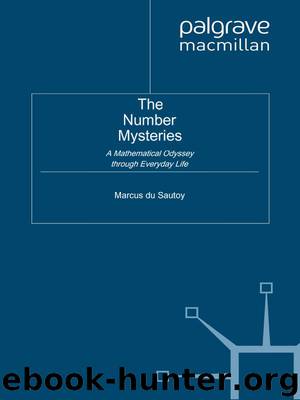The Number Mysteries: A Mathematical Odyssey through Everyday Life (MacSci) by du Sautoy Marcus

Author:du Sautoy, Marcus
Language: eng
Format: epub
Publisher: Palgrave Macmillan
Published: 2011-05-24T00:00:00+00:00
HOW CAN MATH HELP YOU WIN AT MONOPOLY?
Monopoly appears to be a pretty random game. You throw two dice and speed around the board in your car or strut along in your top hat, buying property here, building hotels there. Every now and again you might come second in a beauty contest thanks to a Community Chest card or have to cough up $20 for drunk driving. Each time you pass GO, you collect another $200. How on earth can math give you an edge in this game?
Over the course of the game, which is the most visited square on any Monopoly board? Is it the GO square where you start, the Free Parking diagonally opposite, or perhaps Virginia Avenue or the Boardwalk? The answer is in fact the Jail square. Why? Well, you could just throw the dice and find yourself just visiting, or you might find that the dice takes you to the square diagonally opposite, where a policeman tells you to go to jail. You might even be unlucky and pick up one of the Chance or Community Chest cards that send you straight to jail. And if that wasn’t enough ways to send you down, if you throw a double, you get to go again, but if you throw three doubles in a row, then rather than being rewarded for your impressive feat of dice rolling, that too is punished with a three-turn sentence.
As a result, on average, players find themselves visiting the Jail square about three times more often than most other squares on the board. That isn’t much help to us at the moment, because you can’t buy the jail. But here is where the math comes to the fore: where are players most likely to land after being in jail? The answer depends on the most likely throw of the dice when they leave that square.
Each die can land equally on one of the six faces. With two dice, that gives 6 x 6 = 36 different possible throws, each equally likely. But when you analyze those possibilities, you find that a score of 2 or 12 is very unlikely, because there’s only one way to make either of these combinations, whereas there are six ways to make a total score of 7.
Download
This site does not store any files on its server. We only index and link to content provided by other sites. Please contact the content providers to delete copyright contents if any and email us, we'll remove relevant links or contents immediately.
| Algebra | Calculus |
| Combinatorics | Discrete Mathematics |
| Finite Mathematics | Fractals |
| Functional Analysis | Group Theory |
| Logic | Number Theory |
| Set Theory |
Modelling of Convective Heat and Mass Transfer in Rotating Flows by Igor V. Shevchuk(6390)
Weapons of Math Destruction by Cathy O'Neil(6138)
Factfulness: Ten Reasons We're Wrong About the World – and Why Things Are Better Than You Think by Hans Rosling(4691)
Descartes' Error by Antonio Damasio(3228)
A Mind For Numbers: How to Excel at Math and Science (Even If You Flunked Algebra) by Barbara Oakley(3217)
Factfulness_Ten Reasons We're Wrong About the World_and Why Things Are Better Than You Think by Hans Rosling(3197)
TCP IP by Todd Lammle(3130)
Fooled by Randomness: The Hidden Role of Chance in Life and in the Markets by Nassim Nicholas Taleb(3042)
Applied Predictive Modeling by Max Kuhn & Kjell Johnson(3018)
The Tyranny of Metrics by Jerry Z. Muller(2999)
The Book of Numbers by Peter Bentley(2906)
The Great Unknown by Marcus du Sautoy(2645)
Once Upon an Algorithm by Martin Erwig(2597)
Easy Algebra Step-by-Step by Sandra Luna McCune(2576)
Lady Luck by Kristen Ashley(2528)
Practical Guide To Principal Component Methods in R (Multivariate Analysis Book 2) by Alboukadel Kassambara(2495)
Police Exams Prep 2018-2019 by Kaplan Test Prep(2481)
All Things Reconsidered by Bill Thompson III(2354)
Linear Time-Invariant Systems, Behaviors and Modules by Ulrich Oberst & Martin Scheicher & Ingrid Scheicher(2331)
